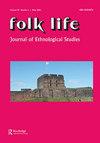帝国的敌人:第一次世界大战期间大英帝国的平民拘留
IF 0.1
4区 社会学
0 FOLKLORE
引用次数: 1
摘要
关于真实和虚构的争论开始出现,因为虚假的降神会开始出现,在这种降神会中,灵媒表演虚假的幽灵,声称与真正的灵魂交流。作者列举了18和19世纪其他著名的名字,如梅斯默和他的实验,阿兰·卡德克的“编纂者”的招魂术,以及灵媒布拉瓦茨基夫人。它们表明了19世纪现代降神会的特征:灵媒们围坐在桌子旁与灵魂交流。莫顿非常详细地研究了美国福克斯姐妹的现象,展示了她们有条理的沟通结构。此外,威廉·克鲁克斯(William Crookes)和他关于敏感的人和心灵感应的辩论,研究通灵现象的社团的出现以及胡迪尼幻觉的事件,根据作者的说法,证明了关于与灵魂交流的辩论的智力努力。最后,莫顿指出,降神会在20世纪的延续是基于江湖骗术、占卜板和灵质实验。她还向我们讲述了这个话题在当代的应用,例如关于死后生命的医学报告,与警方合作破案的灵媒,以及超自然活动和心灵感应的实验。此外,读者会注意到人们的心态、宗教和习俗随着时间的推移而变化,但怀疑论者和信徒之间的共识是不变的:人类天生渴望相信,在某种程度上,死后生命还会继续。无论是通过寻找超越唯物主义哲学的答案,还是通过寻求一些安慰来处理失去亲人的问题,人类总是在寻求某种解释。这本书对于那些从未读过这个话题的读者来说是一个很好的第一次接触。它针对的是普通大众,因此,线性的历史分期使新手能够实现在整个人类历史中绘制现象的意图。通俗易懂的语言可以流畅地阅读,最重要的是,让书变得有趣。作者没有直接引用历史文献;然而,这本书探讨了一个大的参考书目,是一个有用的资源,为那些有兴趣在追求进一步的主题。尽管她专注于探索英语国家的现象,偶尔也提到其他国家的降神会,但作者从与灵魂交流的领域对人物的盘点为读者提供了广泛的研究可能性。本文章由计算机程序翻译,如有差异,请以英文原文为准。
Enemies in the Empire: civilian internment in the British Empire during the First World War
debates about truth and fiction as false seances began to occur, in which mediums performed fake apparitions, claiming to communicate with real spirits. The author lists other renowned names from the eighteenth and nineteenth centuries such as Mesmer and his experiments, Allan Kardec ‘the codifier’ of Spiritism, and the Spiritualist medium Madame Blavatsky. They indicated what the nineteenth century would characterize as the modern seances: meetings of mediums around tables for communicating with spirits. Morton dedicates herself in great detail to the phenomenon of the Fox sisters in the United States, demonstrating their methodical structuring of the communication. In addition, William Crookes and his debate on sensitive people and telepathy, the emergence of societies for the study of spiritualist phenomena and Houdini’s illusions were events that, according to the author, prove the intellectual effort towards the debate concerning the communication with spirits. Finally, Morton points out the continuity of seances in the twentieth century on the grounds of charlatanism, Ouija boards and experiments with ectoplasm. She also tells us about the contemporary application of the topic, for instance the medical reports about life after death, mediums who work with the police to solve cases, and the experiments with paranormal activities and telepathy. Moreover, the reader will notice the fluidity of people’s mentalities, religions and practices through time, but the consensus between sceptics and believers remains the same: humans possess an innate desire to believe that, somehow, life continues after death. Whether by searching for answers beyond the materialistic philosophies or by seeking for some comfort to deal with the loss of beloved ones, humanity has always sought some kind of explanation. This book is a good first contact for readers who have never read about the topic. It is aimed at the general public and, for this reason, the linear historical periodization allows neophytes to realize the intention of mapping the phenomenon throughout the history of humanity. The accessible language enables a fluid reading and, most importantly, makes the book enjoyable. The author does not quote from historical documentation directly; however, the book explores a large bibliography, being a helpful resource for those interested in pursuing the subject further. Despite her focus on exploring the phenomena in Englishspeaking countries, with occasional mentioning of seances in other countries, the author’s inventory of personalities from the field of communication with spirits offers a wide range of research possibilities for readers.
求助全文
通过发布文献求助,成功后即可免费获取论文全文。
去求助
来源期刊
CiteScore
0.30
自引率
66.70%
发文量
17
期刊介绍:
Folk Life: Journal of Ethnological Studies is a journal devoted to the study of all aspects of traditional ways of life in Great Britain and Ireland. The journal publishes original, high quality, peer-reviewed research in the form of unsolicited articles, solicited papers (which are usually selected from those read at the Society"s annual conference) and of members" papers (which are usually short reports of work in progress). Work published in Folk Life may include, for example, papers dealing with the traditional ways of life of other countries and regions, which may be compared to or contrasted with those of Great Britain and Ireland.

 求助内容:
求助内容: 应助结果提醒方式:
应助结果提醒方式:


